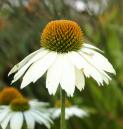 The dried rhizome and roots of Gelse'mium sempervir'ens Aiton.
The dried rhizome and roots of Gelse'mium sempervir'ens Aiton.
BOTANICAL CHARACTERISTICS.—Stem smooth, climbing. Leaves short-petiolate, shining, ovate. Flowers in short axillary clusters, very fragrant; corolla bright yellow, funnel-form, 5-lobed.
HABITAT.—Southern United States, notably Florida.

 DESCRIPTION OF DRUG.—Generally in very light and fibrous cylindrical sections, 90 to 200 mm. long, 4 to 15 mm. in diameter; externally of a brownish-yellow color, slightly wrinkled; tough, breaking with a fibrous, splintery fracture; bark thin, with silky bast fibers, adhering to the light-yellowish, porous, broadly rayed wood; the wood-cells are more or less indurated and free of starch-grains; medullary rays contain few starch-granules; pith small; odor characteristic; taste persistently bitter.
DESCRIPTION OF DRUG.—Generally in very light and fibrous cylindrical sections, 90 to 200 mm. long, 4 to 15 mm. in diameter; externally of a brownish-yellow color, slightly wrinkled; tough, breaking with a fibrous, splintery fracture; bark thin, with silky bast fibers, adhering to the light-yellowish, porous, broadly rayed wood; the wood-cells are more or less indurated and free of starch-grains; medullary rays contain few starch-granules; pith small; odor characteristic; taste persistently bitter.
ADULTERATION.—Mixed with the true gelsemium there are sometimes found the roots of the jessamine or jasmine; as an adulterant this has become known as false gelsemium. The true yellow jasmine (Jasminum fructicans Linné) is called "Gelsemium officinale" in Europe. In cross-section the false root, according to Dohme, has no indurated cells in the medulla. Its medullary rays are full of starch-grains, and the sieve-ducts at the outer end of the woody cylinder are, in the case of every woody wedge, surrounded and protected by several rows of bast fibers. The true gelsemium has no such bast fibers. Accidental admixture of stems may be detected by the latter having bundles of bast fibers near the cortex. In the rhizome the fibers are not in bundles, but in a more or less interrupted ring.
Powder.—Microscopical elements of: See Part iv, Chap. I, B.
CONSTITUENTS.—Gelsemine, C54H69N4O12, gelseminine, gelseminic acid, volatile oil, resins, gallic acid, etc. Gelsemine is a brittle, white, transparent solid, soluble in alcohol, from which it crystallizes with difficulty. Gelseminine (uncrystalline) and Sempervirine, yellowish-red crystals. The latter has been separated in minute quantities (Sayre). The root yields from 0.3 to 0.5 per cent. of alkaloids. Gelseminine is rapidly growing in favor as presenting most of the benefits occurring from the use of morphine without any of the disadvantages of the latter (Ellingwood). The activity seems to reside principally in the gelseminine.
Preparation of Gelsemine.—Add acetic acid to concentrated tincture; precipitate resin with water; concentrate the aqueous filtrate; remove gelsemic acid with chloroform or ether. The acid liquid yields impure alkaloid when precipitated by Na2CO3. This is purified by solution in chloroform and slow evaporation. It is a white, amorphous, very bitter alkaline alkaloid; with HCl or HNO3 forms crystalline salts.
ACTION AND USES.—Antispasmodic, sedative, and diaphoretic. Dose: 2 to 10 gr. (0.13 to 0.6 Gm.).
- OFFICIAL PREPARATIONS.
- Fluidextractum Gelsemii Dose: 2 to 10 drops (0.13 to 0.6 mil).
- Tinctura Gelsemii (10 per cent.), 2 to 15 drops (0.14 to 1 mil).
- Extractum Gelsemii, 0.01 Gm. (1/6 gr.).

